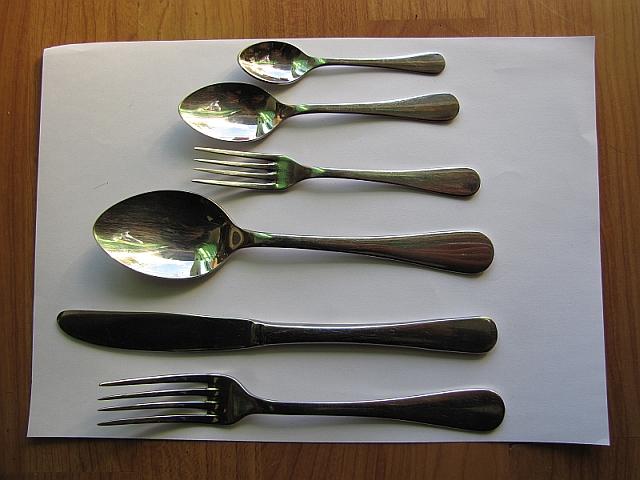
Chloe
participating member-
Posts
136 -
Joined
-
Last visited
-
Sorry about the previous post. This is my own photo of Magefesa Laredo cutlery showing the whole set, with the perfect-miniature dessert fork and a very nice sturdy little coffee spoon. Oops, just remembered that I forgot to include the dessert knife. It's exactly the same as the main knife, but in length comes to about half way up the blade of the larger knife. I must have bought them about 16 or 17 years ago and I've been really happy with them ever since.
-
Can I add that the strange, sad looking cake that appears in several of the pictures is a sponge cake made with so many egg yolks that it really does simply sag in the middle Typical recipes: 10 whole eggs, 30 egg yolks, 500g sugar, 250g flour; or 22 yolks, 4 whites, 250g sugar, 125g flour. Baked in a tin lined with thick white paper. The saggy mountain effect is also helped by a very hot oven to start with, then turned down as soon as the cake has risen. It should be almost liquid in the middle. Yummyyyyy!! Chloe (wishing Alcobaça wasn't so far ... the church itself is one of the most beautiful I know) Edit to add the name of the cake: Pão-de-ló de Alfeizarão - now pronounce that if you dare
-
Ah! To be really pedantic, in Portugal it's bacalhau ... Seriously, I always translate "bacalhau" (whether salt or fresh) as "cod" and always change "codfish" to "cod" (or salt cod, or whatever) on menus sent to me for revision. I don't quite know why the Portuguese are so fond of "codfish" but it is commonly found here. For menus, I much prefer plain old "cod" and "salt cod". Codfish somehow sounds faintly comical, slapping fish around in Asterix books, or something ... Chloe
-
Galicias Restaurants: Reviews & Recommendations
Chloe replied to a topic in Spain & Portugal: Dining
Actually, in correct Galician octopus is polbo - not nearly as amusing to Castilian speakers as the Portuguese spelling... ← Oops, that's true. Sorry ...! Chloe -
Galicias Restaurants: Reviews & Recommendations
Chloe replied to a topic in Spain & Portugal: Dining
The story is that the monastery in Carballiño owned the port in Marín, near Pontevedra, and the fishermen from the ría would pay their rent in octopus, which were abundant and not their normal source of income. Not sure how long the octopus is boiled for - depends on its quality, I dare say - I just boil it until it "pokes" tender, normally at least 20 minutes. For the "feiras", it is boiled in large copper pans. I was there this year and enjoyed some tasty, but (unsurprisingly) overpriced "polvo" (as they call it Galicia - and Portugal - to the amusement of Spaniards from other parts of the country). The next night bar-hopping in Ourense was more interesting, with yummy pigs ears and Galician "chicharrones" (appeared to be some part of the stomach??), among other delicacies. Chloe -
The squash used for cabello de angel or chila is actually a totally different squash, Cucurbita ficifolia. See my own post on Malabar gourd jam a couple of years ago. Chloe north Portugal
-
Throw some mint into the water when you're boiling new potatoes or peas. Very English! Chloe north Portugal
-
I posted a Lemon Polenta cake here http://recipes.egullet.org/recipes/r1298.html reckon it would make a nice addition to the recipe. ← Thanks for the idea! How long do you normally soak the polenta? Chloe
-
I have about a pound of crystallised lemon (in "whole" quarters) that I bought a few months ago and haven't used. I'd be most grateful for suggestions for cakes or desserts. Chloe north Portugal
-
When I was at primary school I told my teacher that my favorite food was Dover sole. Chloe north Portugal
-
Pinxtos should be pintxos tx is a Basque spelling of the sound ch, which is ch in English too. pintxos = pinchos Chloe North Portugal
-
Note that Brazilian and Portuguese linguiças are very different things. Brazilian linguiças are Italian-style fresh sausages, while Portuguese linguiças are cured sausages, i.e. a type of chouriço. Chloe north-west Portugal
-
I spent six months in Brazil and greatly enjoyed something called Frango em Molho Pardo -- literally "Chicken in Dark Sauce." The sauce was blood-based; perhaps it's a similar dish. I tend to be a little squeamish, but this dish was always very tasty. ← Free-range supermarket chickens in Portugal come with a little bag of blood alongside the giblets so that you can make cabidela whenever you want! In northeast Brazil Molho Pardo is also known as Cabidela. Chloe In the bloody (porky) rice capital of Portugal
-
Both my children adore olives and olive oil on everything. Grilled beef has to be very rare otherwise they turn up their noses. They adore goose barnacles and octopus, and whole sardines - grilled or fried. Most types of cheese. They love Portuguese bloody, soupy rice dishes - sarrabulho, arroz de frango - and they might call them chocolate rice, but they know very well what's in the dish. My 7-year old girl's favourite foods are mussels and salmon (fresh or smoked). She also loves parmesan cheese, artichokes, snails (French style and Iberian style), fish and shellfish in general. In the summer down south in the Alentejo she was quite crazy over grilled Iberian black pork - segredos and plumas 4-year old boy loves mushrooms, broccoli, artichokes, not so much of a shellfish or snail fiend as his sister, but he's improving! Crunchy chicken skin. They don't like pizzas, hamburgers, hotdogs, peanut butter ... I'm sure I've missed some things out! Salt cod for lunch today. Chloe North Portugal
-
Tuna fish? ← Cod fish!! csp North Portugal

